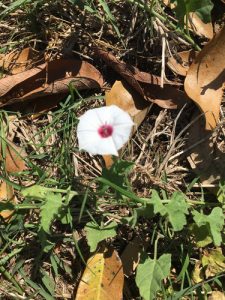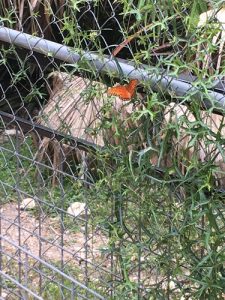When I went to the Austin Zoo last weekend, I came upon this little guy scuttling across my path. As a little kid I always loved to catch lizards and see them up close; I’d grab them quickly but carefully so they didn’t detach their tails and release them right after. I’m from Dallas and we mostly have geckos, so I had never seen a lizard with such pretty spikes in the wild. When I picked up this little guy he bit me pretty good, so one of the things I learned about Texas Spiny Lizards very quickly was that they are not poisonous. A user on INaturalist told me that this was a young one, and I learned later they can grow up to 11 inches. The one I found was probably about 6 inches.
Author: acramer
Blanchard’s Cricket Frog
I would never have noticed this little frog had it not been for the keen eye of my lovely boyfriend. This little guy was so well camouflaged that even when I bent down next to the murky puddle he was by it was hard to spot him. Blanchard’s cricket frogs can be found throughout much of the Midwest, from Colorado to Texas. They are the most aquatic treefrog in North America. Unfortunately, they are considered a threatened or endangered in some states, though not at the federal level, due to habitat loss.
http://www.inaturalist.org/observations/5172963
Pipevine Swallow
When I went camping out in Dripping Springs, the place my boyfriend and I stayed had a beautiful butterfly garden. As we were walking to go get firewood, we noticed an injured butterfly on a gravel path far from the garden. This little Pipevine Swallow wasn’t flying well on his own, but we carried him to a plant inside the garden in hopes that he would be safer there. The caterpillars of this species feed on the Aristolochia plant species, making them poisonous as both larvae and adults, which offers them protection.
http://www.inaturalist.org/observations/5171394
Red Admiral
The Red Admiral is also known as Vanessa atalanta, named after a prominent figure in Greek mythology known as Atalanta. She was a strong hunter who was uninterested in marriage unless the man could beat her in a foot race, which may explain why these butterflies were named after her: they are known as very strong fliers. These butterflies can be found in all 50 states. Males can be very territorial, and will try to chase out anything that enters its territory, with the exception of Red Admiral females.
http://www.inaturalist.org/observations/5171427
Eastern Pondhawk
Unfortunately, when I found this dragonfly it was dead. The astute users on INaturalist informed me that this was a young female who had suffered some injuries. The males are an iridescent blue while the females, like the one I found, are green with black stripes. Eastern pondhawks mate near the ponds where they reside, and within one minute of mating the female lays her eggs as she skims across the pond.
http://www.inaturalist.org/observations/5201870
Oriental False Hawksbeard
I found this Oriental False Hawksbeard on our walk around campus in the garden outside of JBWS. It is a non-native plant in Texas; it is native to Japan and Southeast Asia. It is considered an invasive plant and can be found in places all over the world. I loved it’s little clusters of bright yellow flowers.
http://www.inaturalist.org/observations/5433876
Blue Jay
I see this bird and it’s mate all the time, as they have taken up residence right outside my dorm. These sightings started in the last month or so, so I assume they migrated recently. The migration of blue jays is erratic and they can be found throughout their migration range (from Canada to Texas) during the winter months. Blue Jays can also mimic the calls of hawks, which they may use to warn other jays of the danger.
http://www.inaturalist.org/observations/5660115
Northern Cardinal
This picture is actually of a cardinal in a tiger’s enclosure–pretty risky. I nearly didn’t get a picture of this little guy, but I managed to get one with a little flash of the bird’s red feathers. This bird can proudly claim the title of state bird in 7 different states, which I thought was pretty impressive. What’s it like to be that popular? Apparently the oldest Northern Cardinal ever recorded was over 15 years old. This bird is extremely territorial–so much so that it will even attack it’s own reflection.
http://www.inaturalist.org/observations/5794887
Texas Bindweed
Texas Bindweed, also known as Convolvulus equitans, is common in praries and a member of the morning glory family. This plant is an annual and blooms in April through October. It is a vine that twists around weeds and shrubs and is capable of blocking so much light that these plants die. I thought it was one of the most beautiful wildflowers we saw on our walk through campus.
http://www.inaturalist.org/observations/5434101
Gulf Fritillary
This Gulf Fritillary flew across my path and I spent about 5 minutes tracking it and attempting to get close enough to get a picture. It was frustrating, but worth it once I got a photo that was decent enough to upload. I learned that they are also called the passion butterfly because they lay their eggs near passion vines, which the caterpillar eats when it hatches. I also learned that sometimes they get confused and it is not uncommon for them to lay eggs on people, which I found amusing. They can be found in over ⅔ of the United States.
http://www.inaturalist.org/observations/5801081









